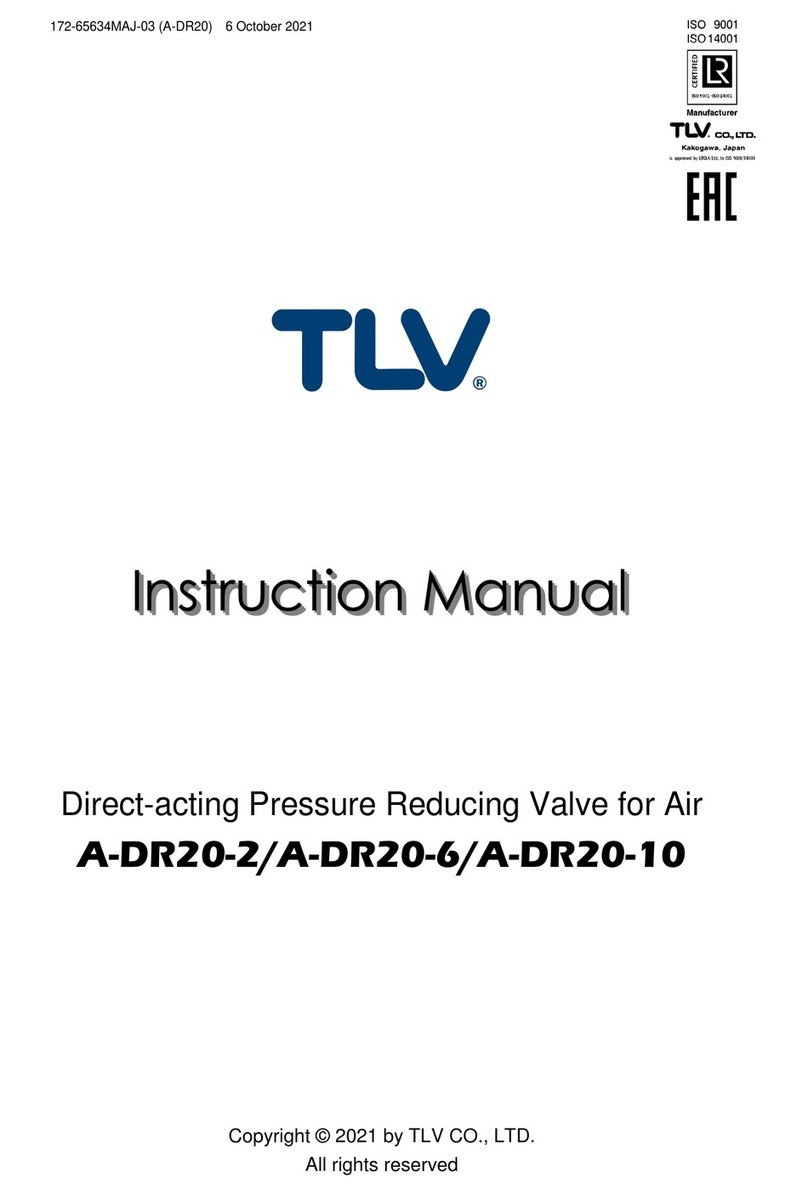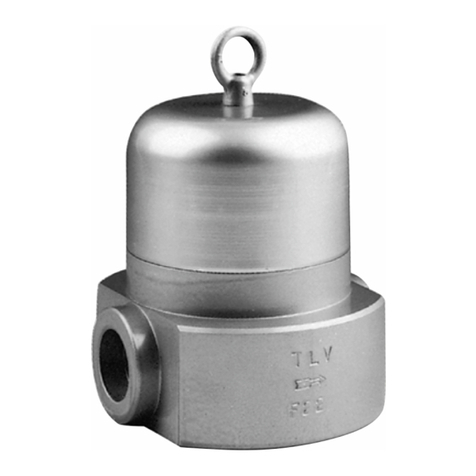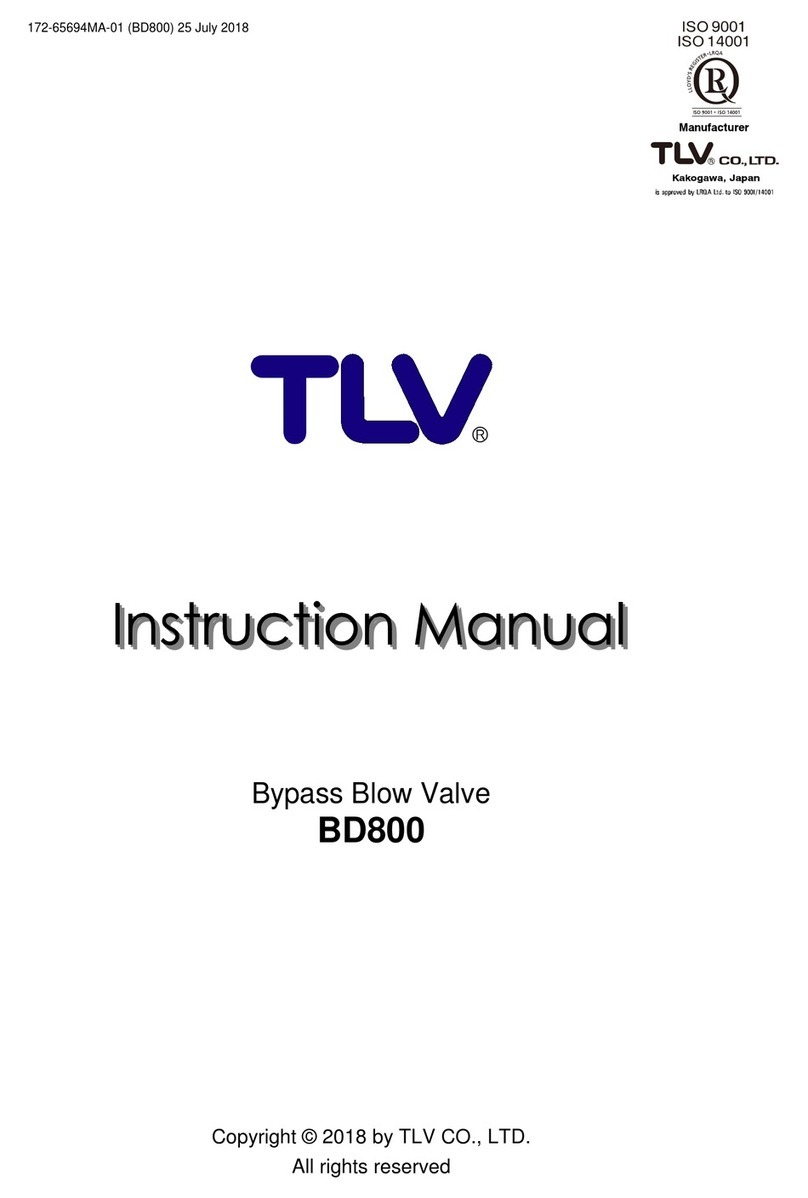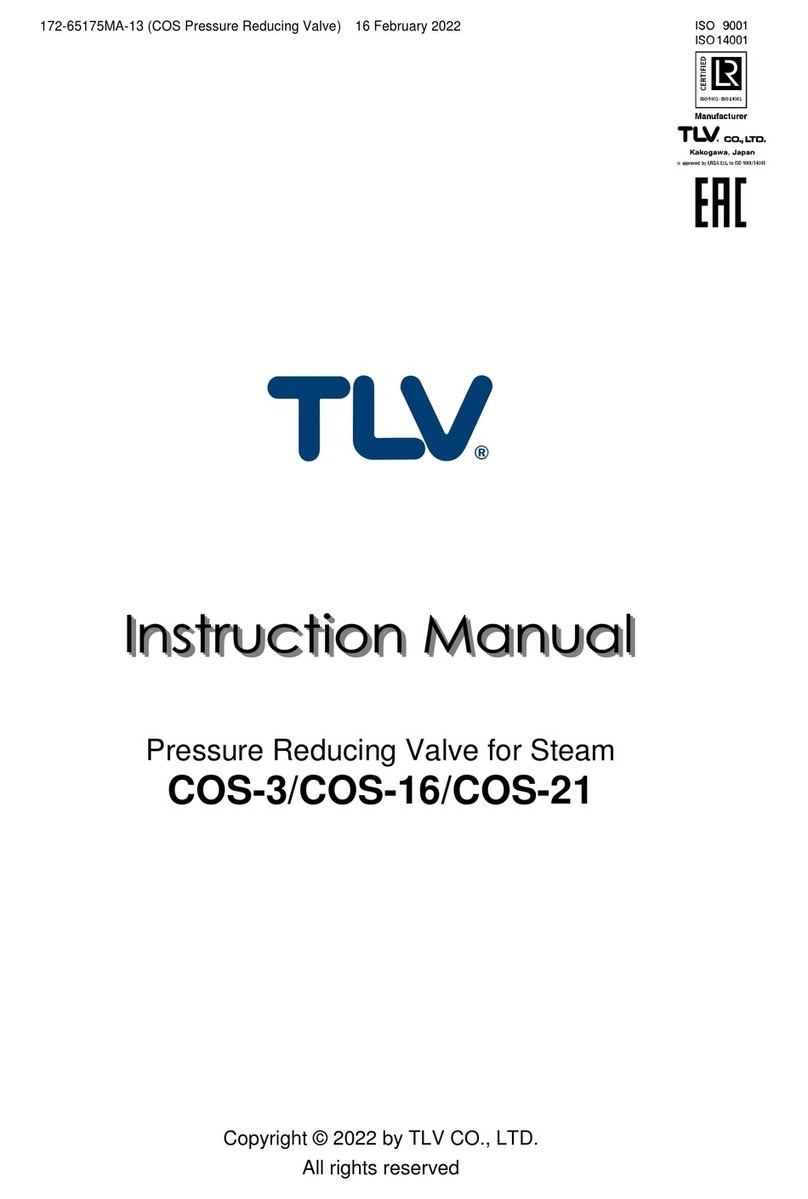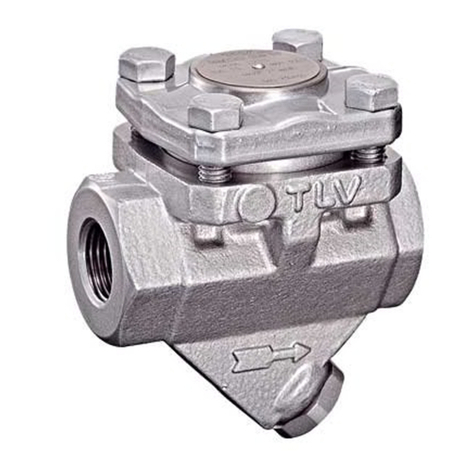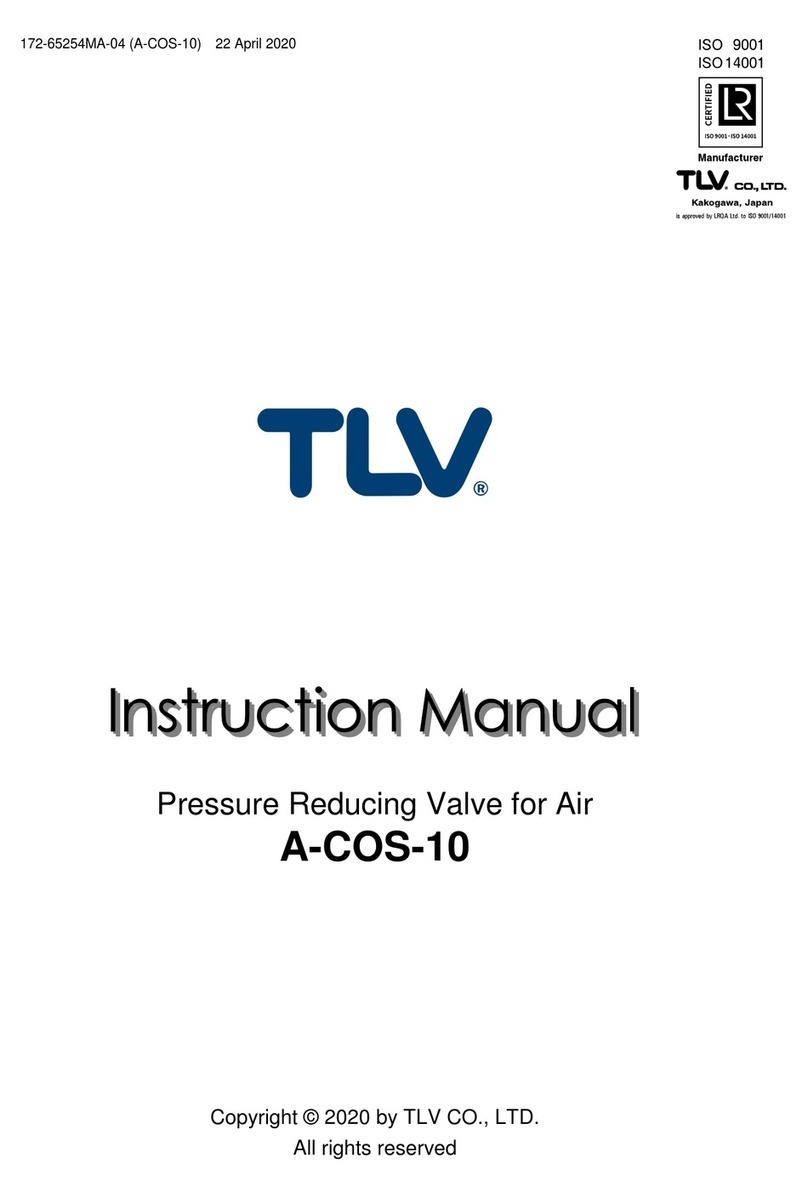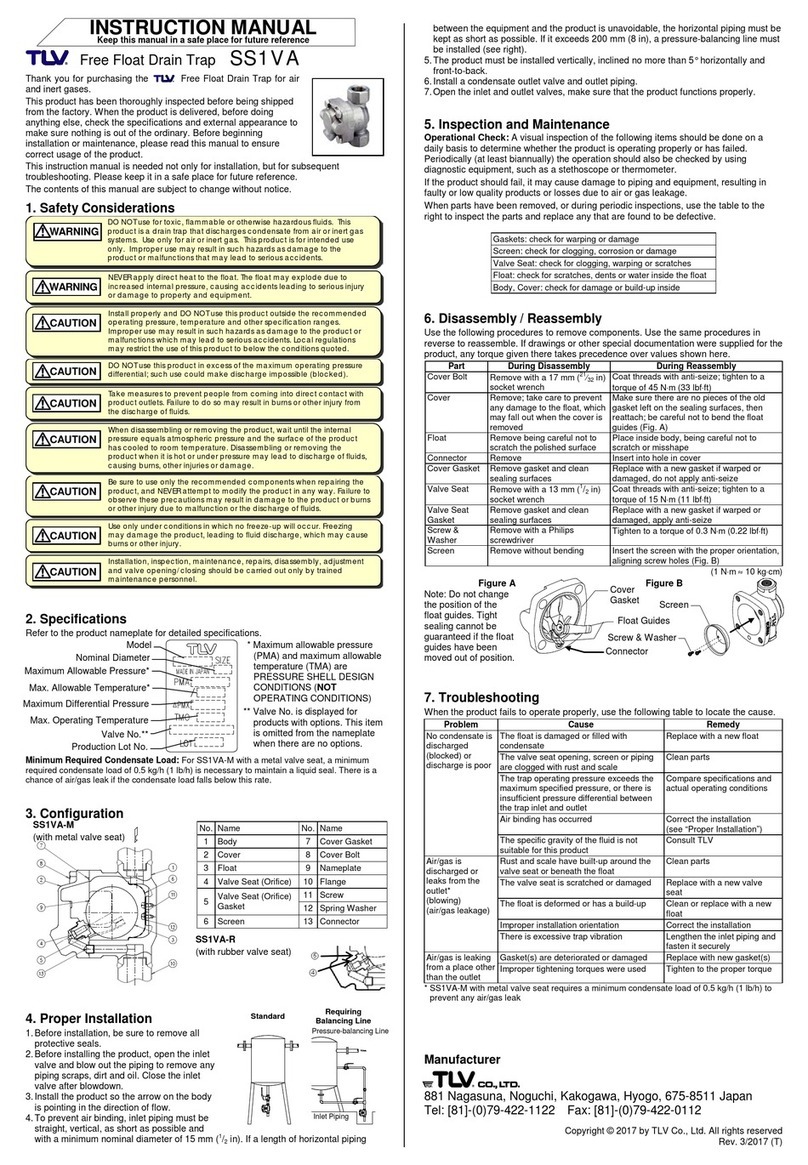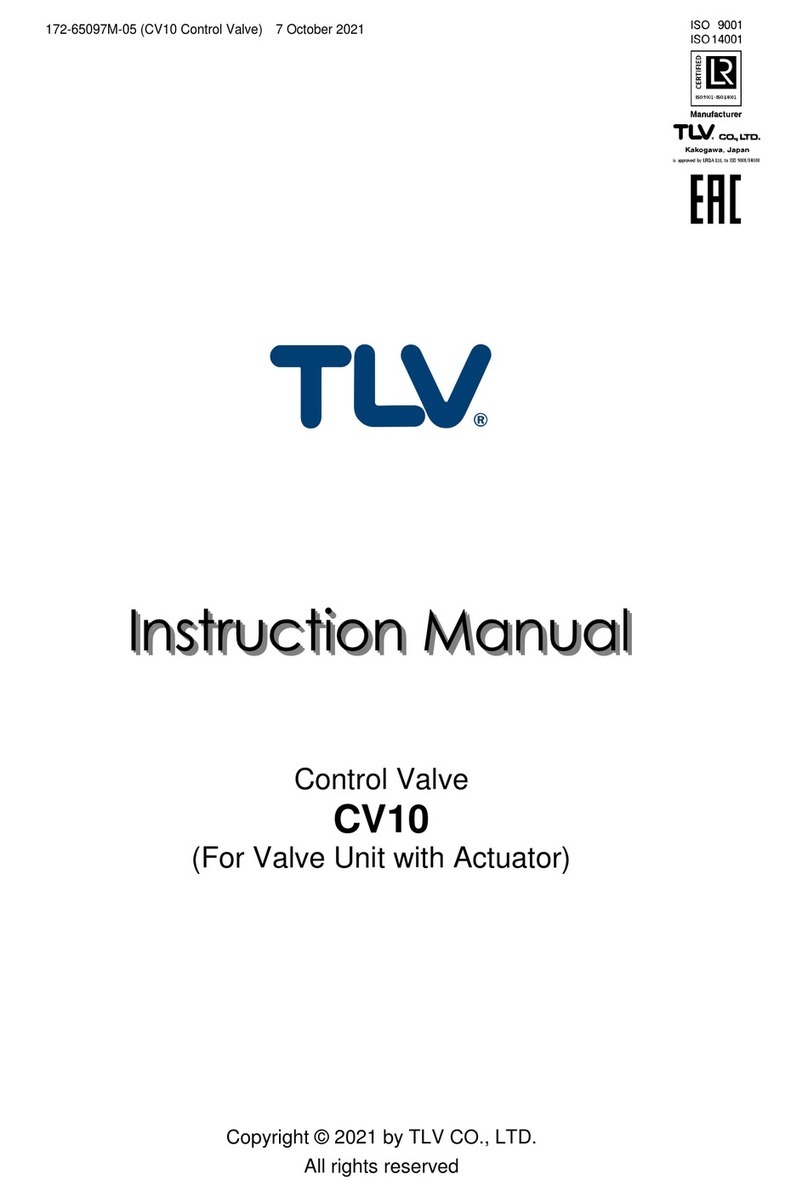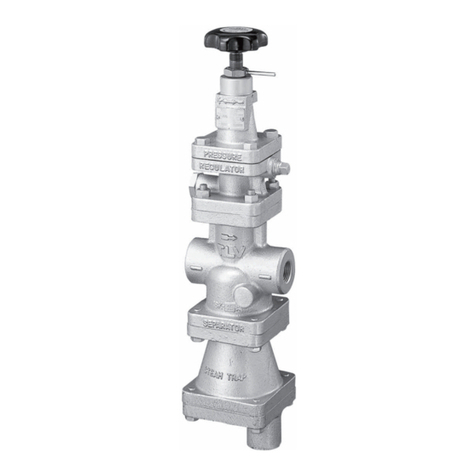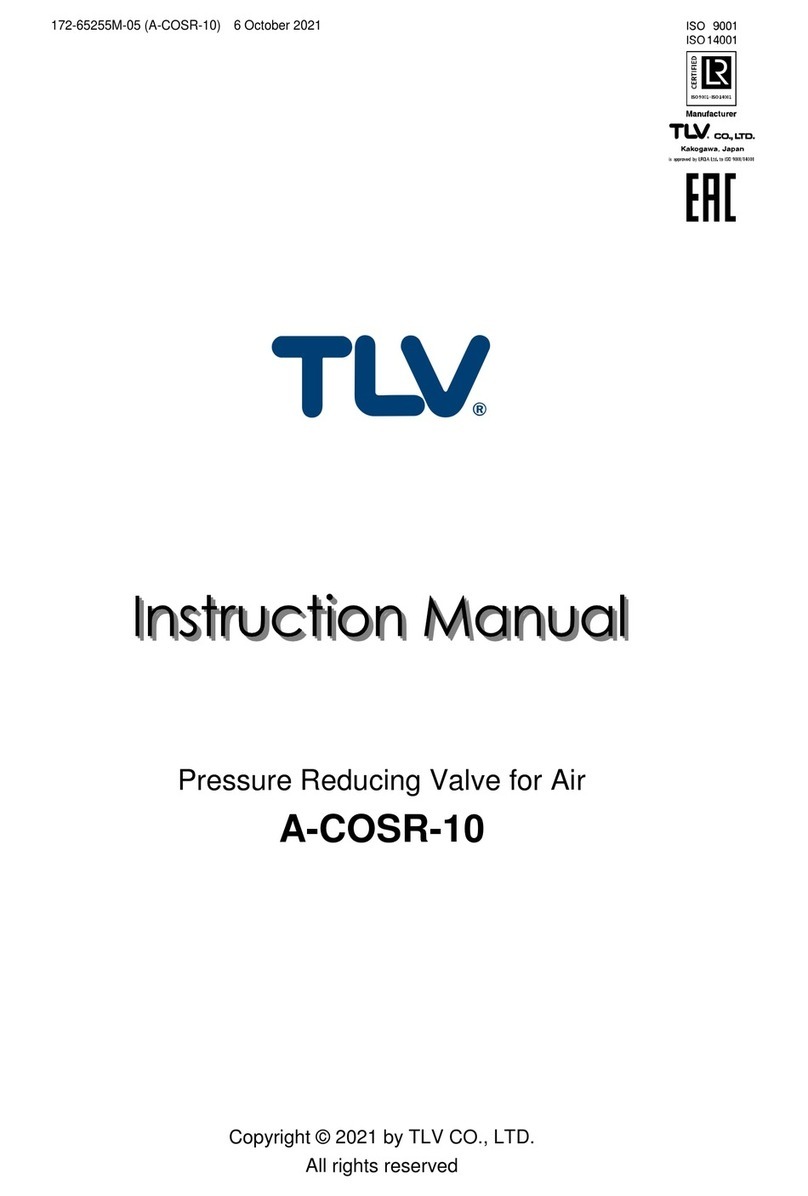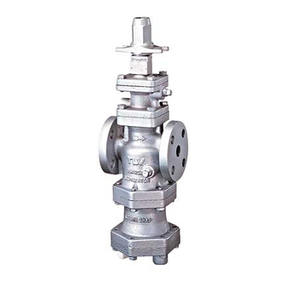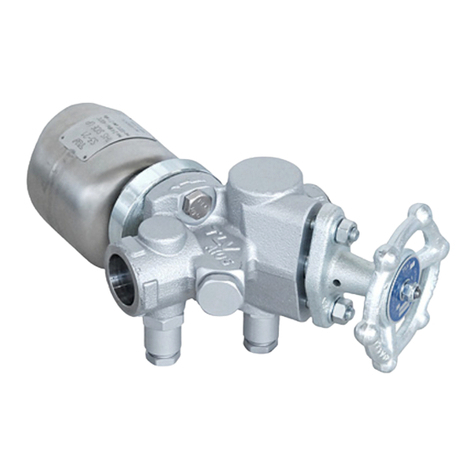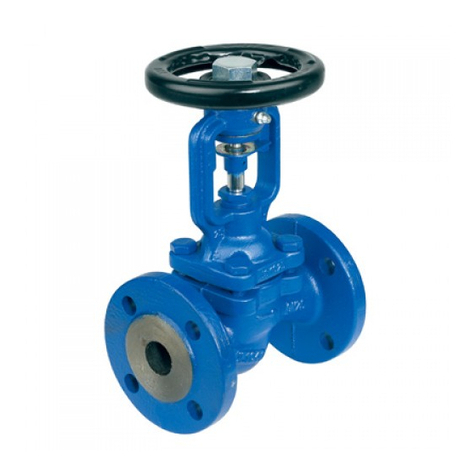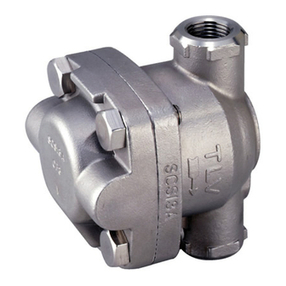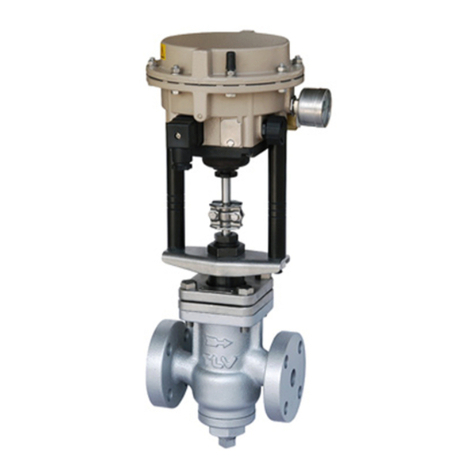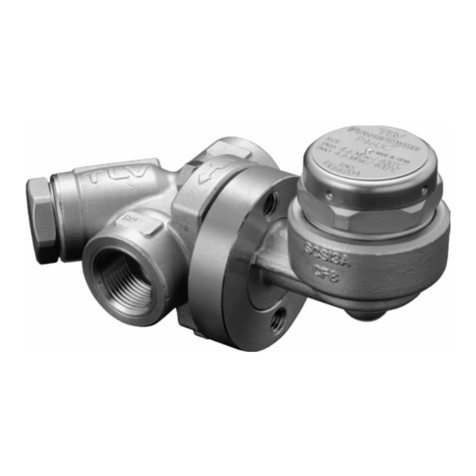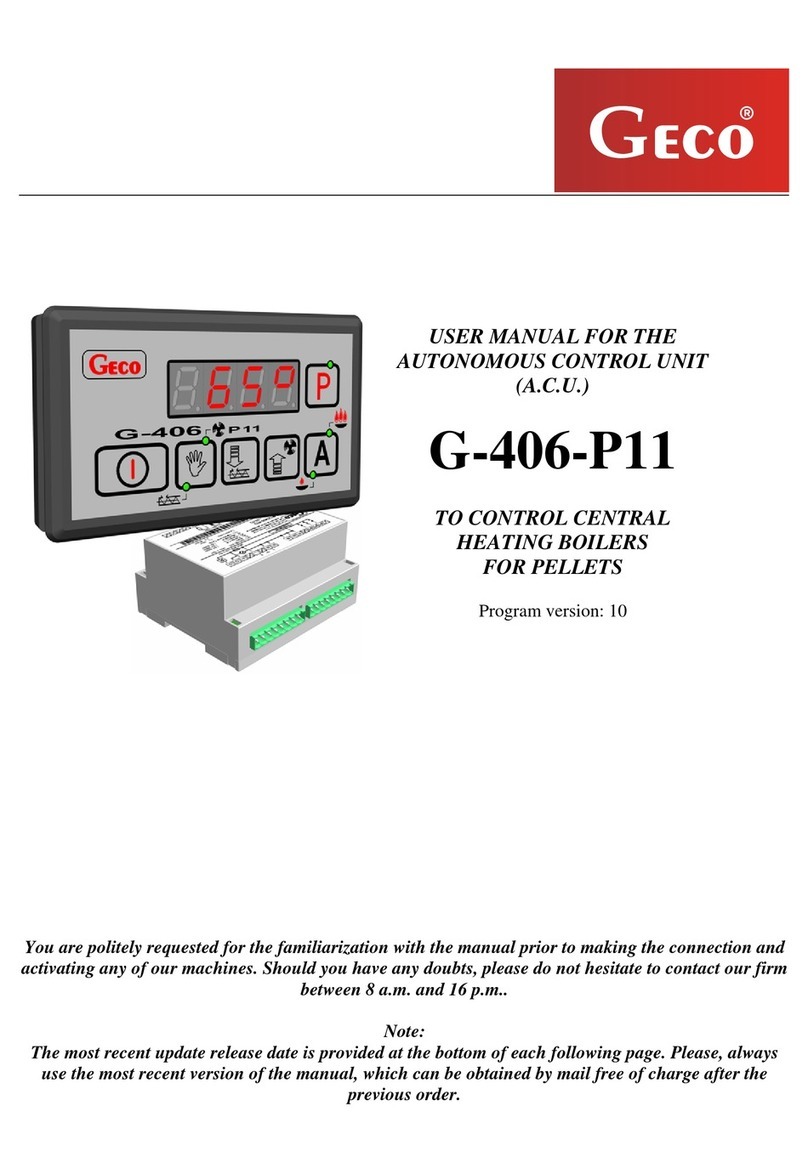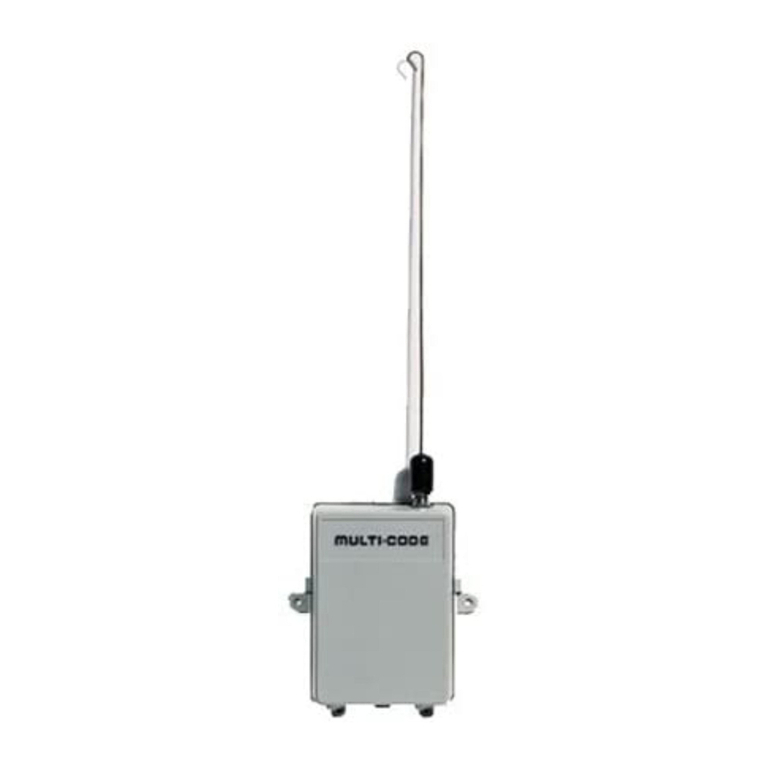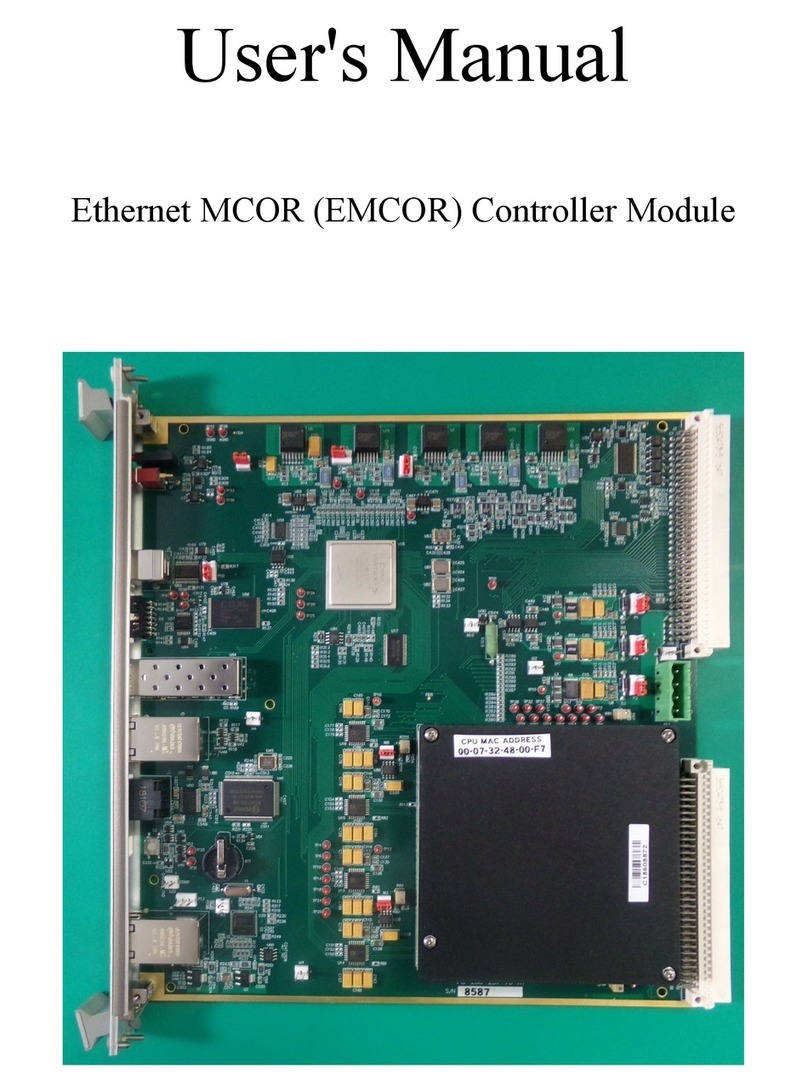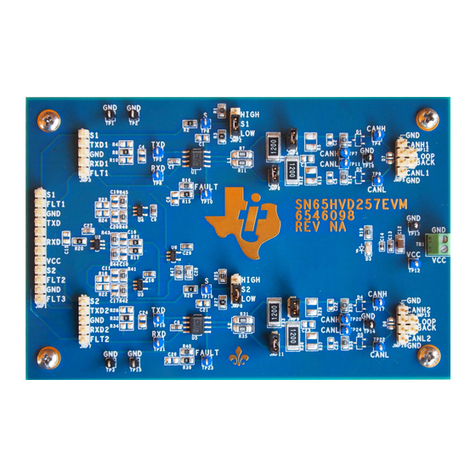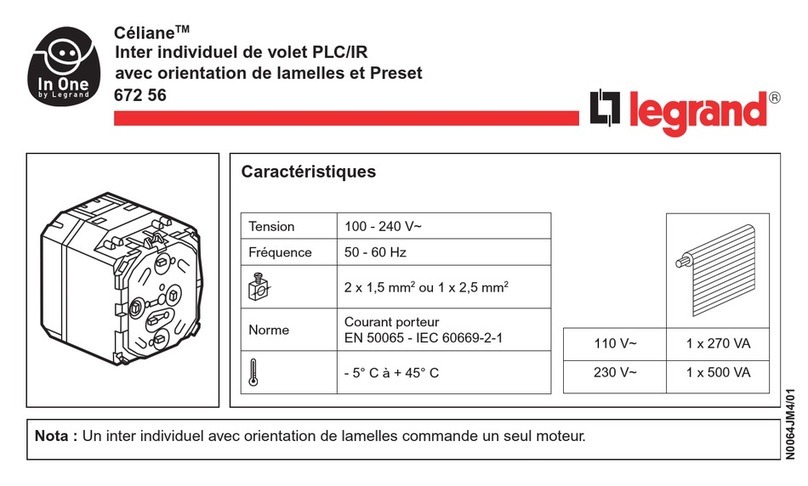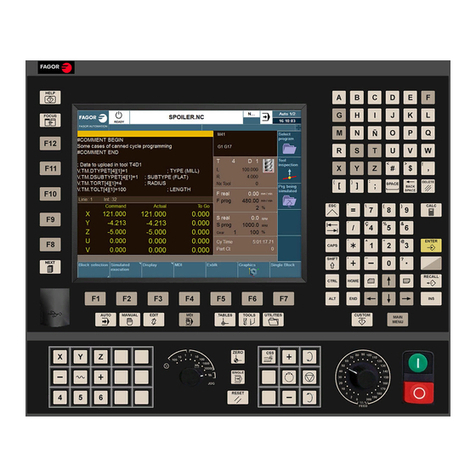TLV DR20 User manual

VALVE FOR STEAM AND/OR AIR
DR20
DIRECT-ACTING PRESSURE REDUCING
MODEL DR20/A-DR20
INSTRUCTION MANUAL
Keep this manual in a safe place for future reference
Copyright (C) 2018 by TLV CO., LTD. All rights reserved.
881 Nagasuna, Noguchi, Kakogawa, Hyogo 675-8511, Japan
Manufacturer
Tel: [81]-(0)79-422-1122 Fax: [81]-(0)79-422-0112
A-DR20

Introduction
Before beginning installation or maintenance, please read this manual to ensure correct use of
the product. Keep the manual in a safe place for future reference.
The DR20 direct-acting pressure reducing valve for steam and air is capable of reducing from
primary pressures of between 0.2 and 1.6 MPaG (30 – 230 psig) to secondary pressures between
0.014 and 1.0 MPaG (2 – 150 psig).
The A-DR20 direct-acting pressure reducing valve for air is capable of reducing from primary
pressures of between 0.2 and 1.0 MPaG (30 – 150 psig) to secondary pressures between 0.014
and 0.9 MPaG (2 – 135 psig).
They are designed for a long service life, and are made of stainless steel for superior durability.
1 MPa = 10.197 kg/cm
2
, 1 bar = 0.1 MPa
For products with special specifications or with options not included in this manual, contact TLV
for instructions.
The contents of this manual are subject to change without notice.
Continued on next page
1. Safety Considerations
• Read this section carefully before use and be sure to follow the instructions.
• Installation, inspection, maintenance, repairs, disassembly, adjustment and valve
opening/closing should be carried out only by trained maintenance personnel.
• The precautions listed in this manual are designed to ensure safety and prevent equipment
damage and personal injury. For situations that may occur as a result of erroneous handling,
three different types of cautionary items are used to indicate the degree of urgency and the
scale of potential damage and danger: DANGER, WARNING and CAUTION.
• The three types of cautionary items above are very important for safety; be sure to observe all
of them, as they relate to installation, use, maintenance, and repair. Furthermore, TLV accepts
no responsibility for any accidents or damage occurring as a result of failure to observe these
precautions.
Indicates an urgent situation that poses a threat of death or serious injury.
Indicates a DANGER, WARNING or CAUTION item.
Indicates that there is a potential threat of death or serious injury.
CAUTION
WARNING
DANGER
CAUTION Indicates that there is a possibility of injury, or equipment/product damage.
Install properly and DO NOT use this product outside the recommended
operating pressure, temperature and other specification ranges.
Improper use may result in such hazards as damage to the product or
malfunctions, which may lead to serious accidents. Local regulations may
restrict the use of this product to below the conditions quoted.
Take measures to prevent people from coming into direct contact
with product outlets.
Failure to do so may result in burns or other injury from the discharge of
fluids.
When disassembling or removing the product, wait until the internal
pressure equals atmospheric pressure and the surface of the product
has cooled to room temperature.
Disassembling or removing the product when it is hot or under pressure
may lead to discharge of fluids, causing burns, other injuries or damage.
1

CAUTION
Do not use excessive force when connecting threaded pipes to the
product.
Over-tightening may cause breakage leading to fluid discharge, which
may cause burns or other injury.
Be sure to use only the recommended components when repairing
the product, and NEVER attempt to modify the product in any way.
Failure to observe these precautions may result in damage to the product
or burns or other injury due to malfunction or the discharge of fluids.
Use only under conditions in which no freeze-up will occur.
Freezing may damage the product, leading to fluid discharge, which may
cause burns or other injury.
Use under conditions in which no water hammer will occur.
The impact of water hammer may damage the product, leading to fluid
discharge, which may cause burns or other injury.
2. Specifications
Refer to the product nameplate for detailed specifications.
* Valve No. is displayed for products with options. This item
is omitted from the nameplate when there are no options.
To avoid malfunctions, product damage, accidents or serious injury,
install properly and DO NOT use this product outside the specification
range. Local regulations may restrict the use of this product to below
the conditions quoted.
CAUTION
1 MPa = 10 bar = 10.197 kg/cm2
Operating Range
Model
Primary Pressure Range
0.2 – 1.6 MPaG
2 – 16 barg
30 – 230 psig
0.6 – 1.6 MPaG
6 – 16 barg
85 – 230 psig
0.54 – 1.0 MPaG
5.4 – 10 barg
76 – 150 psig
0.18 – 0.6 MPaG
1.8 – 6 barg
27 – 85 psig
0.014** – 0.2 MPaG
0.14** – 2 barg
2** – 30 psig
Adjustable Pressure Range*
DR20-2 DR20-6 DR20-10
* Secondary pressure must not exceed 90% of primary pressure
** But not less than of primary pressure
30
1
/
Model
Production Lot No.
Nominal Diameter Valve No.*
Maximum Operating
Temperature
Primary Pressure Range
Secondary Pressure
Adjustable Range
Applicable
Fluids
DR20: Steam, Air
A-DR20: Air
Model
Primary Pressure Range 0.2 – 1.0 MPaG
2 – 10 barg
30 – 150 psig
0.6 – 1.0 MPaG
6 – 10 barg
85 – 150 psig
0.54 – 0.9 MPaG
5.4 – 9 barg
76 – 135 psig
0.18 - 0.6 MPaG
1.8 - 6 barg
27 – 85 psig
0.014** - 0.2 MPaG
0.14** - 2 barg
2** – 30 psig
Adjustable Pressure Range*
A-DR20-2 A-DR20-6 A-DR20-10
2

3. Configuration
*1Replacement parts are available only in the following kits:
A: Maintenance kit
B: Repair kit for Spacer
C: Repair kit for Main Valve
D: Repair kit for Bellows
*2Number of parts: 2 pieces
*3Shipped as a unit
1
2
3
4
5
6
7
8
9
10
11
12
13
14
15
Body
Cover
Screen
Coil Spring
Main Valve
Valve Seat Gasket
Valve Seat
Spacer*3
Description
No.
16
17
18
19
20
21
22
Snap Ring
Valve Stem
Bellows
Cover Gasket
Coil Spring
Spring Guide
Steel Ball
Cover Bolt
Locknut
Adjustment Handle
Nameplate
Retaining Ring
Slide Bearing*2 *3
Snap Ring*2 *3
A*1B*1
D*1
C*1
A*1B*1D*1
C*1
A*1B*1
D*1
C*1
Description
No. Description
No.
18
17
20
16
2
1
3
4
5
6
7
19
9
10
11
12
13
14
15
8
10
22
22
21
For A-DR20: Rubber (standard: fluorine
rubber) is used in the seating area. The
rubber is inlaid in the main valve.
Soft Seat (Fluorine rubber)
DR20 A-DR20
3

4. Exploded View
Adjustment Handle
Locknut
Cover Bolt
Cover
Retaining Ring
Steel Ball
Spring Guide
Coil Spring
Bellows
Snap Ring
Valve Stem
Valve Seat
Valve Seat Gasket
Main Valve**
Coil Spring
Screen
Body
Cover Gasket
Snap Ring*
Slide Bearing*
Spacer
Slide Bearing*
Snap Ring*
* Cannot be removed individually as it is incorporated with the spacer and must be replaced as
a set with the spacer.
** For A-DR20: The rubber is inlaid in the main valve and cannot be removed. The main valve
itself must be replaced.
4

5. Piping and Installation
• Installation, inspection, maintenance, repairs, disassembly, adjustment and
valve opening/closing should be carried out only by trained maintenance
personnel.
• Take measures to prevent people from coming into direct contact with
product outlets.
• Install for use under conditions in which no freeze-up will occur.
• Install for use under conditions in which no water hammer will occur.
If a pressure reducing valve is installed either directly before or after an elbow or control valve,
unevenness in flow may result in chattering and unstable pressure.
To ensure stable flow, it is recommended that the pressure reducing valve be installed on
straight runs of piping, as illustrated below.
Inlet (primary side) of the pressure reducing valve d = pipe diameter
• Maintain a straight piping run of 10 d or
more when a manual valve, a strainer or
an elbow, etc. is installed.
(Example: if nominal size is 25 mm (1”),
have 250 mm (10”) or more)
• Maintain a straight piping run of 30 d or
more when an automated valve (on-off
valve) is installed.
(Example: If nominal size is 25 mm (1”),
have 750 mm (30”) or more)
Outlet (secondary side) of the pressure reducing valve
• Maintain a straight piping run of 15 d or
more when a manual valve, a strainer or
an elbow, etc. is installed.
(Example: If nominal size is 25 mm (1”),
have 375 mm (15”) or more)
• Maintain a straight piping run of 30 d or
more when a safety valve is installed.
(Example: If nominal size is 25 mm (1”),
have 750 mm (30”) or more)
• Maintain a straight piping run of 30 d or
more when another pressure reducing valve
is installed. (Two-stage pressure reduction)
(Example: If nominal size is 25 mm (1”),
have 750 mm (30”) or more)
10 d or more
30 d or more
30 d or more
30 d or more
15 d or more
5.1 Recommended Straight Pipe Runs
CAUTION
1
2

5.2
Installing an ON / OFF Valve (solenoid valve or motorized valve)
If an on-off valve is required to stop the supply of steam or air to the equipment, install
it on the inlet side of the DR20/A-DR20. If a solenoid valve is installed at the outlet of the
DR20/A-DR20, it will cause heavy chattering and may lead to damage of the DR20/A-DR20.
(When the on-off valve opens, the secondary pressure of the DR20/A-DR20 changes from 0 to
the set pressure, passing through an area where the reduction ratio is less than 30:1, where
adjustment is normally impossible, causing momentary chattering.) To save energy, install the
on-off valve as near to the boiler or air compressor as possible.
NOTE: To prevent water hammer in steam systems , it is recommended that a slow-acting
motorized on-off valvebe used. If a fast-acting solenoid valve is used, the potential water
hammer effect can damage the steam equipment and the pressure reducing valve.
5.3 Installing a Control Valve and a Safety Valve
A control valve (i.e. for temperature control in steam systems) installed between the
DR20/A-DR20 and the equipment (downstream of the DR20/A-DR20) may raise pressure
between the DR20/A-DR20 and the control valve when the control valve is closed, depending on
their spatial relationship. Therefore, the control valve should be installed close to the equipment.
Also, a safety valve should be installed downstream of the control valve.
NOTE: When installing a safety valve to protect the equipment, be sure to install it on the
equipment or directly before the inlet of the equipment. If the safety valve is
installed between the DR20/A-DR20 and a control valve, an eventual pressure rise could
activatethe safety valve.
Make sure the DR20/A-DR20 is installed on horizontal piping with the
adjustment handle facing up. Ensure the raised TLV lettering on the body is
horizontal and the arrow is pointing in the direction of flow. The allowable
inclination of the DR20/A-DR20 is 10。
front-to-back and 15。
horizontally.
5.4 Blowdown
Before installing the DR20/A-DR20 unit, be sure to blow down all piping thoroughly. If this is not
possible, perform a blowdown using the bypass valve. Blowdown is especially important for
newly installed piping or after the system has been shut down for a long period of time.
5.5 Remove Protective Seals
Before installation, remove the protective seals covering the product inlet and outlet.
5.6 Tolerance Angle for lnstallation
DR20/
A-DR20 Safety
Valve
Control
Valve
Steam or Air
using Equipment
10
。
10
。
15
。
15
。
6

5.7 Piping Supports / Maintenance Space
Leave sufficient
space for
maintenance,
inspection and
repair.
Install the
DR20/A-DR20,
paying attention to
avoid excessive load,
bending and
vibration.
Supporting the inlet
and outlet pipes
securely is
recommended.
5.10 Accessories
Always install a shut-off valve and pressure gauge at both the inlet and outlet, and a shut-off
valve in the bypass line. Ball valves, which will not retain condensate, are recommended for inlet
and outlet shut-off valves. The bypass pipe should be at least 1/2 the size of the inlet pipe.
5.8 Piping Size / Diffuser
If the secondary side flow velocity is expected to be more than 30 m/s (100 ft/s), install a
diffuser in order to keep the flow velocity below 30 m/s (100 ft/s). If the distance between the
reducing valve and the equipment is great, a possible drop in pressure should be taken
into consideration when selecting the piping size.
5.9 Two-stage Pressure Reduction
Employ 2-stage pressure reduction if the required reduction is not possible due to operating
range limitations (when it is not possible to reduce the pressure to the desired pressure using a
single pressure-reducing valve).
Straight piping: 10 d or longer upstream 15 d or longer downstream
Pressure
Gauge
Pressure
Gauge
Globe Valve
Diffuser
Safety Valve
(Relief Valve)
Ball Valve Ball Valve
DR20/A-DR20
150
mm
(6″)
150
mm
(6″)
150 mm
(6″)
150 mm
(6″)
7

Loosen the locknut
Increase Pressure Decrease Pressure
Raise the
adjustment handle
CounterclockwiseClockwise
6. Adjustment
Follow the below procedures for adjusting DR20/A-DR20. Especially if the DR20 pressure
reducing valve is installed in a steam system, it should be properly adjusted for protection of the
steam equipment against water hammer.
1. It is necessary to blow down all pipe lines thoroughly.
The blowdown is especially important if the line is new or has been shut down for a long
period of time. Take particular care to ensure that matter such as condensate and dirt does
not remain inside the equipment.
(Stay clear of any pressurized blow-out from the safety valve.)
2. Make sure that the shut-off and bypass valves located upstream and downstream of the
DR20/A-DR20 are completely closed.
3. Loosen the locknut, then turn the adjustment handle counter-clockwise to free the coil spring.
4. Slowly, fully open the shut-off valve at the inlet of the DR20/A-DR20.
5. Slightly open the shut-off valve at the outlet of the DR20/A-DR20.
6. Turn the adjustment handle clockwise until the desired outlet pressure is obtained. Wait
several minutes.
7. Slowly, fully open the shut-off valve at the outlet of the DR20/A-DR20.
8. After setting, retighten the locknut.
9. When shutting down the system, always close the outlet shut-off valve first and then the inlet
valve.
8

7. Inspection and Maintenance
To ensure the long service life of the DR20/A-DR20, the following inspection and maintenance
should be performed regularly, at least once a year. It is especially important to perform an
inspection immediately after the initial run of a new line or before or after equipment such as a
heater is out of service for a long period of time.
Wait for the body to cool before attempting to remove the DR20/A-DR20 from the line. Then
remove the DR20/A-DR20 from the piping and secure it in a vise to perform the inspection.
Parts Inspection Procedure
Body, Cover
Screen
Valve and Valve Seat
Valve Stem
Bellows
Gaskets
Check inside for damage, dirt, grease, oil film, rust or scale
Check for clogging, damage or deformation
Check for rust, scale, oil film, wear or damage
Check for wear or damage
Check for cracks, damage or deformation
Check for warping or damage
7.1 Disassembling the Adjustment Section
Loosen the adjustment handle completely
and remove the cover bolts. After removing
the cover, you will see the steel ball, the
spring guide and the coil spring.
Check for seizure or any damaged screw
threads.
7.2 Disassembling the Bellows Section
Remove the bellows from the body, then the
valve stem. Pinch the straight sections of
the snap ring that is holding the spacer
together using a tool such as a needle-nose
pliers and remove the snap ring. Remove
the spacer.
• Installation, inspection, maintenance, repairs, disassembly, adjustment
and valve opening/closing should be carried out only by trained
maintenance personnel.
• Before attempting to open the product, close the inlet and outlet isolating
valves and wait until the body has cooled completely. Failure to do so may
result in burns.
• Be sure to use the proper components and NEVER attempt to modify the
product.
CAUTION
Cover
Cover Bolt
Locknut
Adjustment
Handle Retaining
Ring
Spring
Guide
Steel Ball
Coil Spring
* Cannot be removed individually as it is incorporated
with the spacer and must be replaced as a set with the spacer.
Bellows
Cover
Gasket
Snap Ring
Valve Stem
Snap Ring*
Slide Bearing*
Spacer
Slide Bearing*
Snap Ring*
Body
9

7.3 Disassembling the Valve Section
Loosen the valve seat with a wrench and
remove it from the body. The coil spring is
exerting an upward pressure on the bottom
of the valve seat, so be careful that the
valve seat is not thrown out. After removing
the valve seat, remove the valve, the coil
spring and the screen.
7.4 Cleaning
After inspection and removal of any abnormality, clean and reassemble the parts.
The following parts will require cleaning before reassembly:
7.5 Reassembling
Reassemble the unit using the same procedure as used for disassembling it; but in reverse order.
In addition, observe the following precautions:
1. PTFE gaskets may be re-used if free from fault, crushing or deformation.
2. Apply anti-seize to the steel ball and threaded portions of screws, bolts and the adjustment
handle. Apply a small amount of anti-seize agent to the threads of the valve seat carefully to
ensure it does not come into contact with other parts.
3. Fasten the bolts one at a time in a diagonal pattern alternately to provide uniform seating.
4. After assembly, make sure that the valve stem operates smoothly without binding. When the
valve is tightened, it may become off-centered under the valve seat. When this occurs, center
the valve under the valve seat.
It is permissible to clean using water. However, cleaning with a mild detergent is recommended
for more effective cleaning.
If drawings or other special documentation were supplied for the product, any torque given
there takes precedence over values shown here.
Threads of the
Adjustment Handle
Threads of the Cover
Bellows
Valve Stem
Main Valve
Spacer (including slide bearing) Valve Seat
Screen
Valve Seat Surface
Tightening Torques and Distance Across Flats
Part
Cover Bolt
Valve Seat
Tightening Torque N・m (lbf・ft)
25 (19)
120 (88)
Distance Across Flats mm (in)
1N・m 10 kg・cm
〜
〜
Valve
Seat
Valve
Seat
Gasket
Coil Spring
Screen
Body
Main
Valve*
13 ( )
2
1
/
27 ( 1
)
16
1
/
* For A-DR20: The rubber is inlaid in the
main valve and cannot be removed.
The main valve itself must be replaced.
10

8. Troubleshooting
This product is shipped after stringent checks and inspection, and should perform its intended
function for a long period of time without failure. However, should there be any problem
encountered in the operation of the DR20/A-DR20, Consult the troubleshooting guide below.
Problem Cause Remedy
No steam/air is being supplied Check the primary/secondary piping
and valves of the unit
The secondary
pressure does
not increase
The valve at the primary side is closed
The entrance to the screens or strainer is clogged
Clean or blow down
Flow rate exceeds specifications
Check the flow rate; check the model selection,
replace with a more suitable unit if necessary
Pressure fluctuation at the primary side
is large
Check the primary pressure; check the
model selection, replace with a more
suitable unit if necessary
Buildup on the valve stem prevents
smooth movement through the spacer
Clean and inspect the valve stem and
spacer
Flow rate fluctuation is too large
Check the flow rate, re-set the pressure;
check the model selection, replace with a
more suitable unit if necessary
The adjustment handle has seized
Replace with a new adjustment handle
The holes in the spacer are clogged Clean
The slide bearing is distorted or
damaged
Replace with a new spacer (when replacing the
slide bearing or snap ring, these parts need to
be replaced as a set with the spacer)
The bellows is distorted or damaged Replace with a new bellows
The selected model is inappropriate for
the service conditions (specifications)
Check the model selection, replace with
a more suitable unit if necessary
The bypass valve is leaking
Check, clean, and replace with a new valve if necessary
There is too high a reduction ratio Use two-stage reduction
The selected model is inappropriate for
the service conditions (specifications)
Check the model selection, replace with
a more suitable unit if necessary
Condensate is entrained Install a steam trap; check the piping
The selected model is inappropriate for
the service conditions (specifications)
Check the model selection, replace
with a more suitable unit if necessary
Flow rate exceeds specifications
Check the flow rate; check the model selection,
replace with a unit that has larger nominal
diameter or a more suitable unit if necessary
The valve installed close to the reducing
valve opens/closes too quickly
Install the valve at as great a distance
away as possible
There is a build-up of dirt on or damage
to the main valve or the valve seat
Clean and align
It exceeds the adjustable pressure
range
Check the model selection, replace
with a more suitable unit if necessary
The flow rate is too low Check the flow rate; check the model
selection, replace with a unit that has
smaller nominal diameter or a more
suitable unit if necessary
Adjustment is
difficult and set
pressure varies
The flow rate is too low
Check the flow rate; check the model selection,
replace with a unit that has smaller nominal
diameter or a more suitable unit if necessary
Hunting or chattering
occurs at low
steam/air demand
The required pressure reduction exceeds specifications
Use two-stage reductionMakes a high-
pitched noise
Hunting never
stops
Chattering
never stops
Upon closing the valves at the
secondary side, the secondary
pressure abruptly rises as high
as the primary pressure
11

9.
Express Limited Warranty
Subject to the limitations set forth below, TLV Corporation, a North Carolina corporation (“TLV”)
warrants that products which are sold by it or TLV International, Inc., a Japanese corporation
(“TII”), which products (the “Products”) are designed and manufactured by TLV Co., Ltd., a
Japanese corporation (“TLVJ”), conform to the specifications published by TLV for the
corresponding part numbers (the “Specifications”) and are free from defective workmanship
and materials. With regard to products or components manufactured by unrelated third parties
(the “Components”), TLV provides no warranty other than the warranty from the third party
manufacturer(s).
Duration Of Warranty
This warranty is effective for a period of the earlier of: (i) three (3) years after delivery of Products
to the first end user in the case of sealed SST-Series Products for use in steam pressure service
up to 650 psig; (ii) two (2) years after delivery of Products to the first end user in the case of
PowerTrap®units; or (iii) one (1) year afterdelivery of Products to the first end user in the case of
all other Products. Notwithstanding the foregoing, asserting a claim under this warranty must be
brought by the earlier of one of the foregoing periods, as applicable, or within five (5) years after
the date of delivery to the initial buyer if not sold initially to the first end user.
ANY IMPLIED WARRANTIES NOT NEGATED HEREBY WHICH MAY ARISE BY OPERATION OF
LAW, INCLUDING THE IMPLIED WARRANTIES OF MERCHANTABILITY AND FITNESS FOR A
PARTICULAR PURPOSE AND ANY EXPRESS WARRANTIES NOT NEGATED HEREBY, ARE
GIVEN SOLELY TO THE INITIAL BUYER AND ARE LIMITED IN DURATION TO ONE (1) YEAR
FROM THE DATE OF SHIPMENT BY TLV.
Exclusive Remedy
THE EXCLUSIVE REMEDY UNDER THIS WARRANTY, UNDER ANY EXPRESS WARRANTY OR
UNDER ANY IMPLIED WARRANTIES NOT NEGATED HEREBY (INCLUDING THE IMPLIED
WARRANTIES OF MERCHANTABILITY AND FITNESS FOR A PARTICULAR PURPOSE), IS
REPLACEMENT; PROVIDED: (a) THE CLAIMED DEFECT IS REPORTED TO TLV IN WRITING
WITHIN THE APPLICABLE WARRANTY PERIOD, INCLUDING A DETAILED WRITTEN
DESCRIPTION OF THE CLAIMED DEFECT AND HOW AND WHEN THE CLAIMED DEFECTIVE
PRODUCT WAS USED; AND (b) THE CLAIMED DEFECTIVE PRODUCT AND A COPY OF THE
PURCHASE INVOICE IS RETURNED TO TLV, FREIGHT AND TRANSPORTATION COSTS
PREPAID, UNDER A RETURN MATERIAL AUTHORIZATION AND TRACKING NUMBER ISSUED
BY TLV. ALL LABOR COSTS, SHIPPING COSTS, AND TRANSPORTATION COSTS
ASSOCIATED WITH THE RETURN OR REPLACEMENT OF THE CLAIMED DEFECTIVE
PRODUCT ARE SOLELY THE RESPONSIBILITY OF BUYER OR THE FIRST END USER. TLV
RESERVES THE RIGHT TO INSPECT ON THE FIRST END USER'S SITE ANY PRODUCTS
Exceptions To Warranty
This warranty does not cover defects or failures caused by:
1. improper shipping, installation, use, handling, etc., by other than TLV or service
representatives authorized by TLV; or
2. dirt, scale or rust, etc.; or
3. improper disassembly and reassembly, or inadequate inspection and maintenance by other
than TLV or service representatives authorized by TLV; or
4. disasters or forces of nature; or
5. abuse, abnormal use, accidents or any other cause beyond the control of TLV; or
6. improper storage, maintenance or repair; or
7. operation of the Products not in accordance with instructions issued with the Products or
with accepted industry practices; or
8. use for a purpose or in a manner for which the Products were not intended; or
9. use of the Products in a manner inconsistent with the Specifications; or
10. failure to follow the instructions contained in the TLV Instruction Manual for the Product.

CLAIMED TO BE DEFECTIVE BEFORE ISSUING A RETURN MATERIAL AUTHORIZATION.
SHOULD SUCH INSPECTION REVEAL, IN TLV’S REASONABLE DISCRETION, THAT THE
CLAIMED DEFECT IS NOT COVERED BY THIS WARRANTY, THE PARTY ASSERTING THIS
WARRANTY SHALL PAY TLV FOR THE TIME AND EXPENSES RELATED TO SUCH ON-SITE
INSPECTION.
Exclusion Of Consequential And Incidental Damages
IT IS SPECIFICALLY ACKNOWLEDGED THAT THIS WARRANTY, ANY OTHER EXPRESS
WARRANTY NOT NEGATED HEREBY, AND ANY IMPLIED WARRANTY NOT NEGATED
HEREBY, INCLUDING THE IMPLIED WARRANTIES OF MERCHANTABILITY AND FITNESS
FOR A PARTICULAR PURPOSE, DO NOT COVER, AND NEITHER TLV, TII NOR TLVJ WILL IN
ANY EVENT BE LIABLE FOR, INCIDENTAL OR CONSEQUENTIAL DAMAGES, INCLUDING,
BUT NOT LIMITED TO LOST PROFITS, THE COST OF DISASSEMBLY AND SHIPMENT OF
THE DEFECTIVE PRODUCT, INJURY TO OTHER PROPERTY, DAMAGE TO BUYER’S OR THE
FIRST END USER’S PRODUCT, DAMAGE TO BUYER’S OR THE FIRST END USER’S
PROCESSES, LOSS OF USE, OR OTHER COMMERCIAL LOSSES. WHERE, DUE TO
OPERATION OF LAW, CONSEQUENTIAL AND INCIDENTAL DAMAGES UNDER THIS
WARRANTY, UNDER ANY OTHER EXPRESS WARRANTY NOT NEGATED HEREBY OR
UNDER ANY IMPLIED WARRANTY NOT NEGATED HEREBY (INCLUDING THE IMPLIED
WARRANTIES OF MERCHANTABILITY AND FITNESS FOR A PARTICULAR PURPOSE)
CANNOT BE EXCLUDED, SUCH DAMAGES ARE EXPRESSLY LIMITED IN AMOUNT TO THE
PURCHASE PRICE OF THE DEFECTIVE PRODUCT. THIS EXCLUSION OF CONSEQUENTIAL
AND INCIDENTAL DAMAGES, AND THE PROVISION OF THIS WARRANTY LIMITING
REMEDIES HEREUNDER TO REPLACEMENT, ARE INDEPENDENT PROVISIONS, AND ANY
DETERMINATION THAT THE LIMITATION OF REMEDIES FAILS OF ITS ESSENTIAL
PURPOSE OR ANY OTHER DETERMINATION THAT EITHER OF THE ABOVE REMEDIES IS
UNENFORCEABLE, SHALL NOT BE CONSTRUED TO MAKE THE OTHER PROVISIONS
UNENFORCEABLE.
Exclusion Of Other Warranties
THIS WARRANTY IS IN LIEU OF ALL OTHER WARRANTIES, EXPRESS OR IMPLIED, AND ALL
OTHER WARRANTIES, INCLUDING BUT NOT LIMITED TO THE IMPLIED WARRANTIES OF
MERCHANTABILITY AND FITNESS FOR A PARTICULAR PURPOSE, ARE EXPRESSLY
DISCLAIMED.
Severability
Any provision of this warranty which is invalid, prohibited or unenforceable in any jurisdiction
shall, as to such jurisdiction, be ineffective to the extent of such invalidity, prohibition or
unenforceability without invalidating the remaining provisions hereof, and any such invalidity,
prohibition or unenforceability in any such jurisdiction shall not invalidate or render
unenforceable such provision in any other jurisdiction.
13901 South Lakes Drive, Charlotte, NC 28273-6790, U.S.A.
Tel : [1]-704-597-9070 Fax: [1]-704-583-1610


Printed on recycled paper.
881 Nagasuna, Noguchi, Kakogawa,
Hyogo 675-8511, Japan
Manufacturer: Tel: [81]-(0)79-422-1122
Fax: [81]-(0)79-422-0112
Rev. 3/2018 (M)PAC-65334-a
Other manuals for DR20
1
This manual suits for next models
1
Table of contents
Other TLV Control Unit manuals
Popular Control Unit manuals by other brands
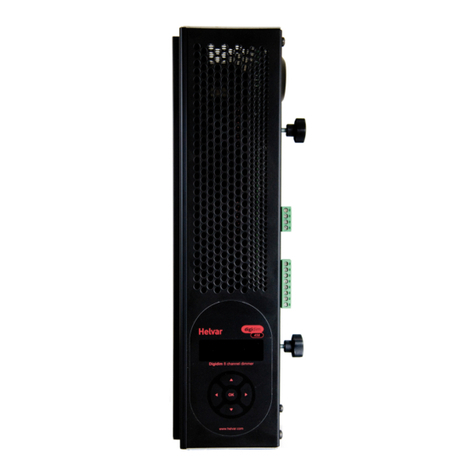
HELVAR
HELVAR 458 DIM8 Installation and user guide
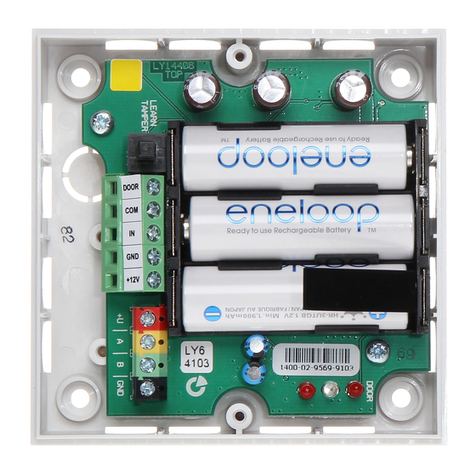
jablotron
jablotron JA-120N quick start guide
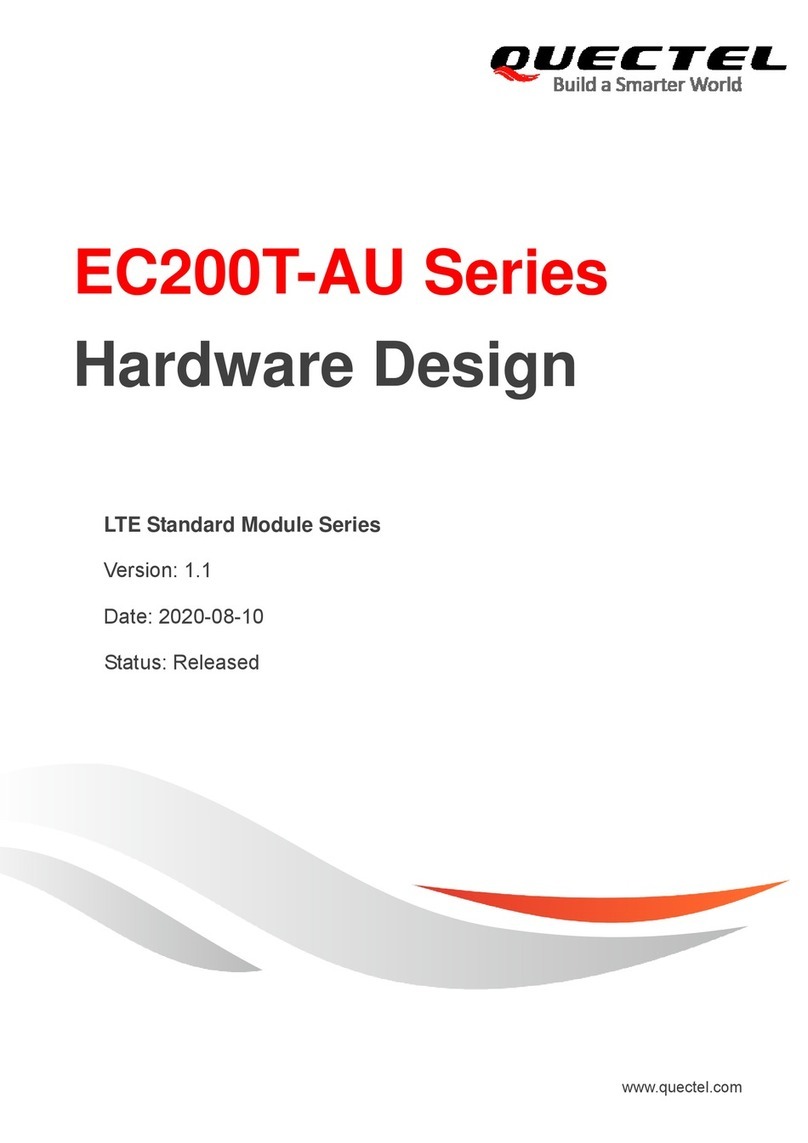
Quectel
Quectel EC200T Series Hardware design

Armstrong
Armstrong TVS 4000F Installation and operation manual
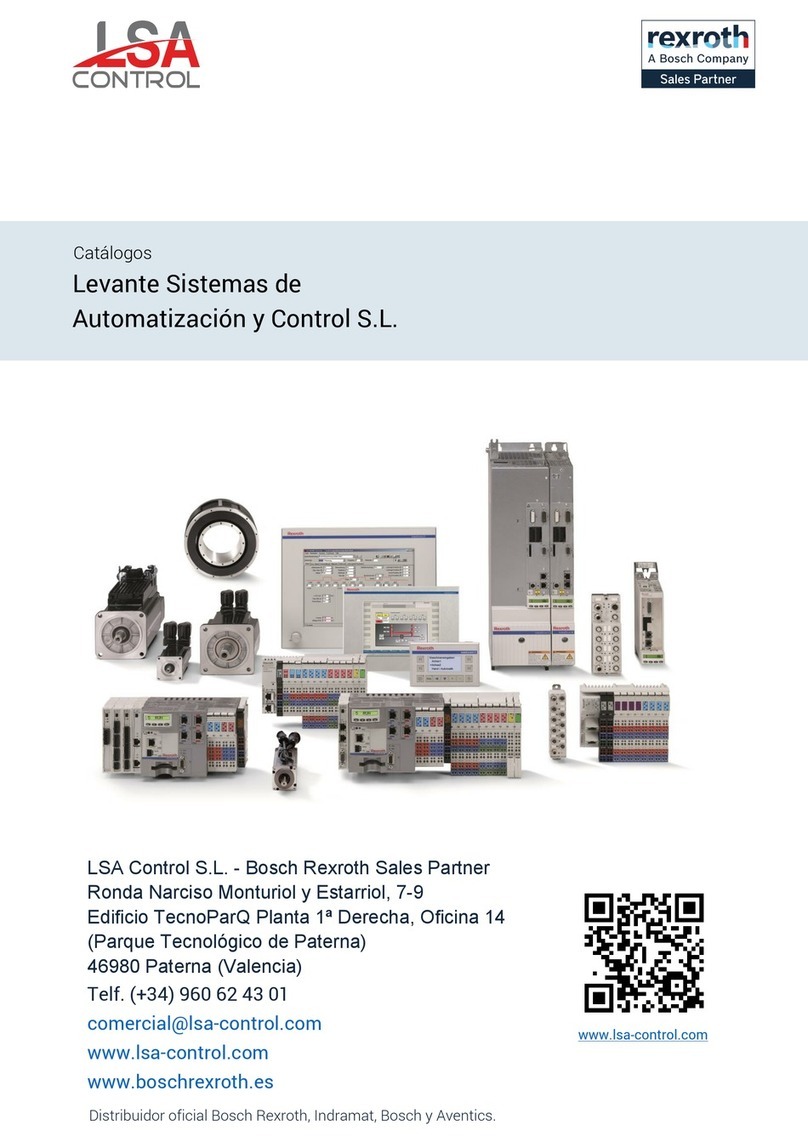
Rexroth Indramat
Rexroth Indramat Mannesmann Rexroth CLM-01.3-M user manual
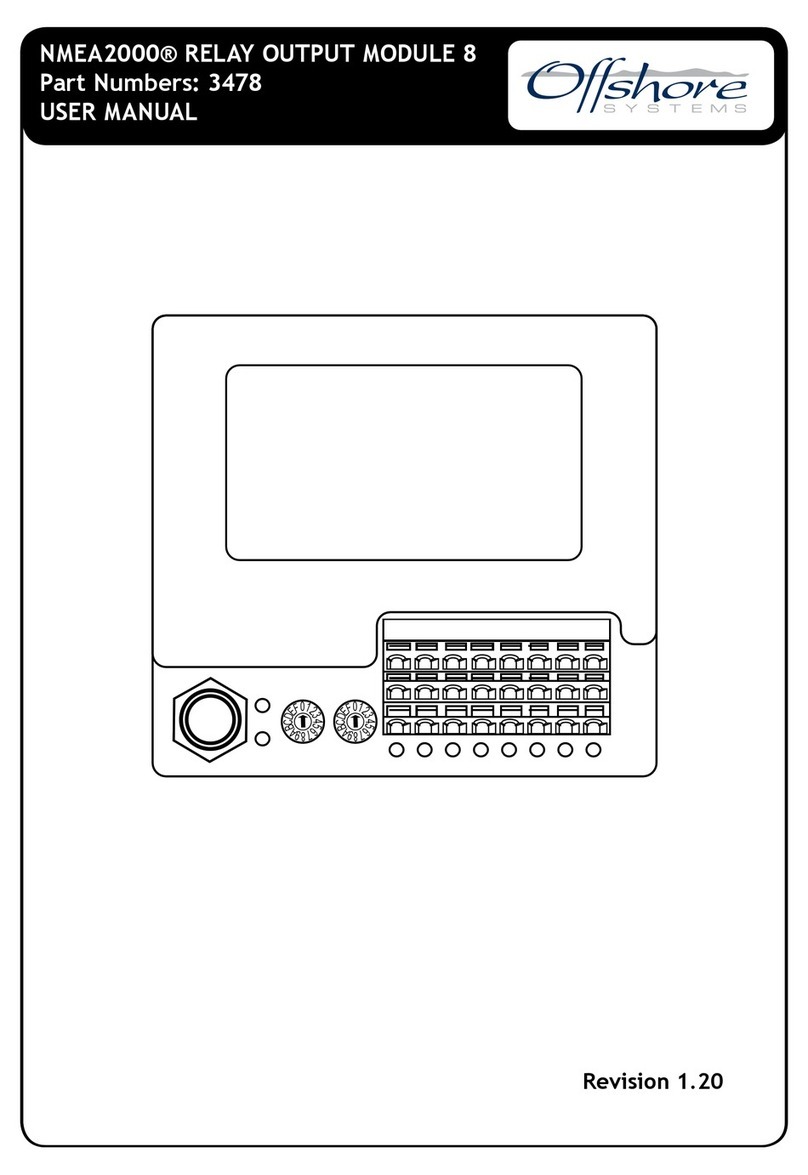
Offshore
Offshore NMEA2000 RELAY OUTPUT MODULE 8 user manual
